Financing Home Renovations

My last column I talked about looking at refinancing your home to consolidate debts or pull money for
renovations to your home. It struck a nerve with several people – I’ve had great conversations with
people I wouldn’t normally have connected with.
February 25 and 26 I will be at the Kelowna Home Show at Prospera place. As I’ve been busy preparing
the subject of home renovations and products has been very much on my mind. If you are going to the
trade show you may come away with ideas for new projects you want to tackle at your own home.
One option that you may not be aware of is a Purchase Plus Improvements mortgage. The short version is that you add the cost of renovations into your home upfront when you buy.
Here’s how this can work.
Let’s say you found a home in a terrific neighbourhood that checks almost all of the boxes on your wish list. The home has a great layout, is in the right school catchment area, and is central to all of the things you like to do in your spare time. The only thing is that the house is really dated inside. Or maybe you want to renovate the basement to add a rental suite.
You have scrimped and saved for your down payment but there is no chance you can come up with
another $40,000 to renovate the kitchen and bathroom and change out the flooring. The house has
great bones but you would like to invest in a home that you will be happy to come back to at the end of your work day.
A Purchase Plus Improvements mortgage can be a brilliant option for you. Here is how the program
works. You find a home priced at $400,000. You do some homework and know that for $40,000 you can give the main floor a complete overhaul and update.
We would put your new mortgage together to reflect your purchase price of $400,000 + $40,000 for the renovations. Your down payment would be $22,000 – only $2,000 more than if you did not add in the renovation budget.
In the first scenario where you buy the home with no renovation funds your monthly payment would be about $2,229. 26. (based on a 5 year fixed rate of 4.69%).
Adding the renovations funds in your payment would be $2,452.19.
For a difference of $222.93 per month, you could move into a freshly updated home that suits your
tastes and family needs.
The additional renovation funds will be held in trust with your lawyer or notary until the renovations are complete, so the challenge can be paying for the work and materials upfront but there are options
available to help with that. If you come to the home show – which is free admission this year – pop by and say hi.
If you’d like to talk about how a Purchase Plus Improvements or a refinance for renovations might be the right fit for I’m happy to answer your questions.






